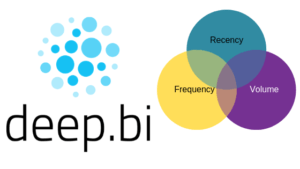What’s happening:
One of today’s hottest topics in digital publishing is finding the “holy grail” of subscriptions — and many leading media companies have shown that a key driver is user engagement. When it comes to measuring engagement, the “MAU” and “DAU” methods introduced by Facebook still seem to be the most popular.
But for Deep BI, these methods are not actionable. Instead, Deep BI took its cue from the Financial Times and uses the RFV engagement score: combining metrics on recency, frequency and volume.
Digging deeper:
The appeal of RFV is the single score, which is easier to follow, compare and use. Also, each part of the score provides valuable metrics that are actionable:
- Recency: Measures the number of days a user has or has not been using the product. This score provides information for taking action to bring users back.
- Frequency: Measures the number of total days within a time period that a user has used the product, to evaluable habits and therefore churn propensity. This score provides information for establishing user routine.
- Volume: Measures content consumption in the number of articles read or a combination of usage interactions. This score helps publishers provide good value to their users; Deep BI considers it the most important usage indicator.
Deep BI has released its RFV metrics on its platform. The company’s system calculates, in real-time, the engagement scores each time a user interacts with a digital product (app, service, website etc.), and augments that interaction with current engagement metrics.
Using engagement metrics
Using RFV, Deep BI to track engagement segments vs. subscribers, number of engaged users over time, churn risk, content categories that users prefer, days with most engaged users, cities with highest engagement, etc. The company uses those RFV scores to:
- Define custom engagement segments
- Define custom churn risk segments
- Count the number of users in each segment
- Calculate dynamics (flow) between segments
- Find key engagement drivers
- Intersecting engagement segments with other types of segments, such as subscription products.
Content from our partners
The bottom line:
Deep BI uses RFV scores to provide metrics to help them grow a paying, loyal user base, using re-engagement strategies such as newsletters, push notifications and ads. The company also uses the system for product improvement and a better recommendation system.












